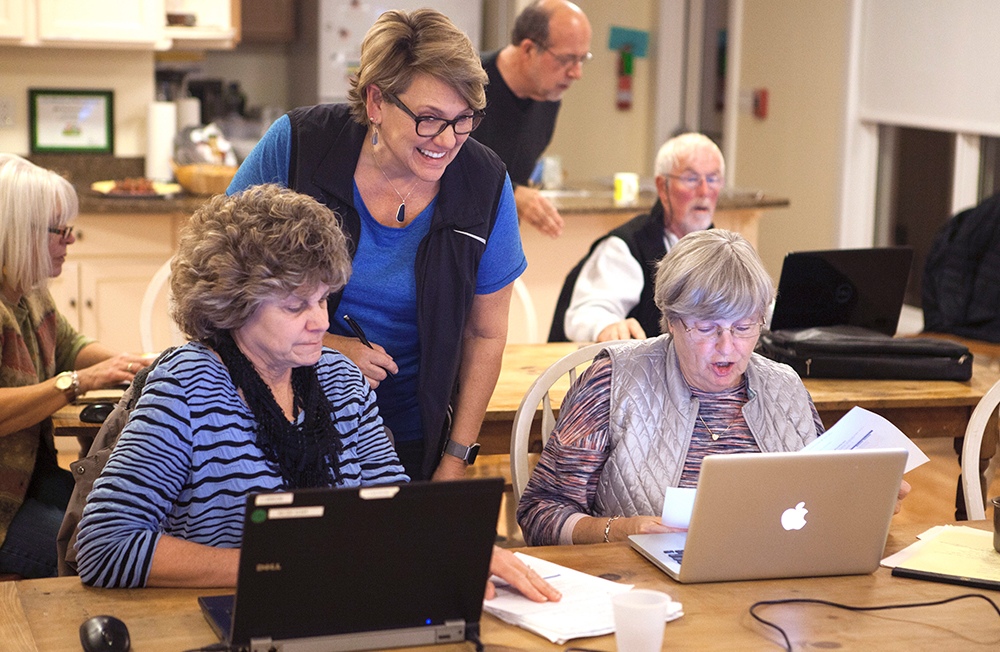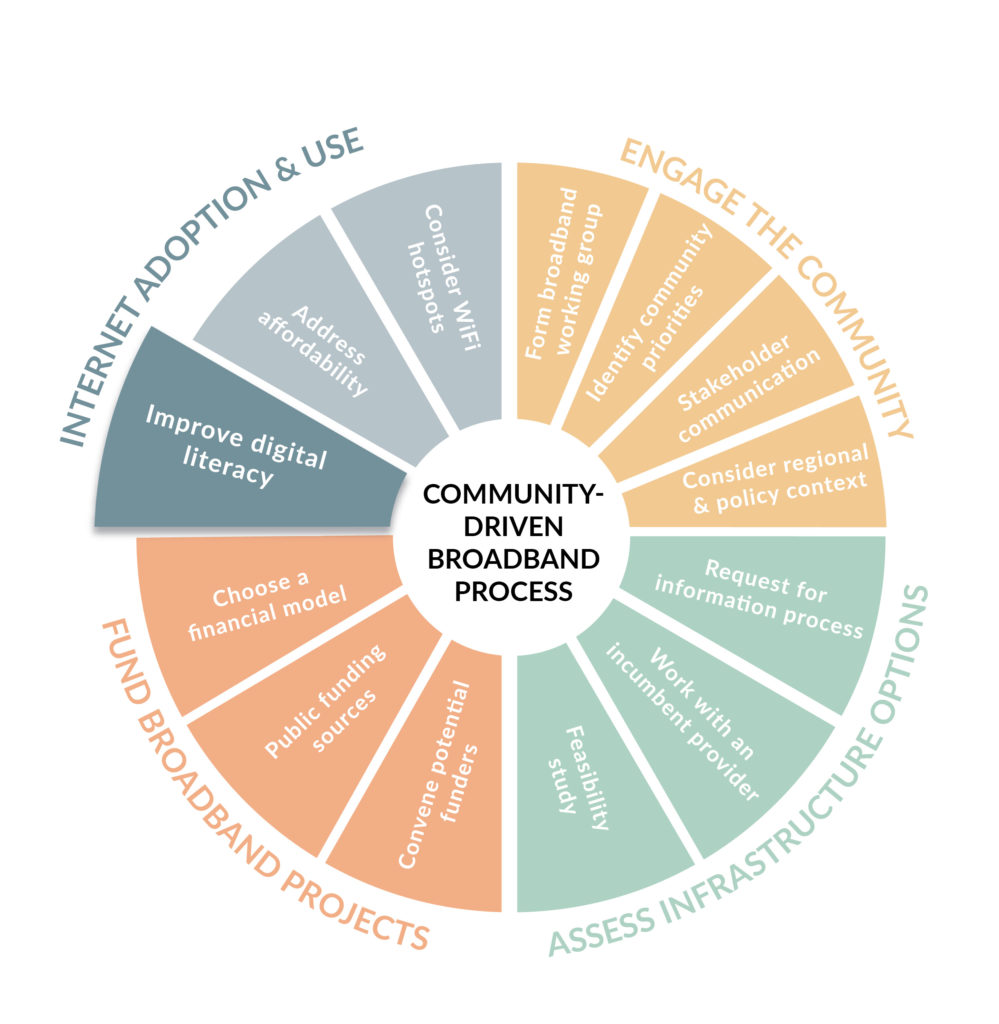BACKGROUND
Digital Literacy
Digital literacy is having the knowledge and competence to use a digital connection to the internet.
Improving digital literacy drives support for better connected communities. If residents have familiarity with accessing the internet, it supports the growth of business, workforce development, healthcare access, civic engagement, student education, and all-around quality of life within a community.
Additionally, regarding the expansion of broadband infrastructure across the rural United States, a higher rate of digital literacy implies a higher rate of adoption, use, and subscription to internet service. A higher rate of subscription (known as a “take rate”) displays community commitment to the success and profit of any infrastructure project. This can equate to lower subscription costs and a higher return on investment for a municipality.
Digital Equity
Digital literacy is a major pillar to the larger goal of digital equity.
The National Digital Equity Center, a nonprofit organization based in Machias, Maine, defines digital equity as:
“A condition in which all individuals and communities have the information technology capacity needed for full participation in our society, democracy, and economy. Digital equity is necessary for civic and cultural participation, employment, lifelong learning, and access to essential services.”
In order for digital equity to be achieved, it is essential that internet service be available, efficient, and affordable. However, it is equally important that all residents of a community have the awareness and proficiency required to utilize it if they desire.
HOW IT WORKS
The National Digital Equity Center (NDEC) is an organization focused on addressing digital equity, in part through public literacy instruction. Originally a program of the private internet service provider, Axiom Technologies, NDEC began with Axiom’s efforts to offer educational courses. As Axiom dived deeper into adult education and other forms of digital literacy training, in October 2018 it created NDEC as a nonprofit organization operating separately from the private company. NDEC launched the Maine Digital Inclusion Initiative, involving many partners throughout the state, raising nearly $4 million (as of October 2020) from federal, state, and philanthropic sources to support its work.
NDEC now provides a range of digital literacy courses for the public free of charge, primarily focused around workforce development and aging in place. Their trainings on computer and internet use have been held in many towns across the state of Maine—particularly in our more rural areas. NDEC also supports Maine communities to develop and implement digital equity and inclusion plans as part of their community-driven broadband projects, keeping digital equity at the forefront of the state’s broadband expansion.
Other states across the nation are also learning from this program. NDEC is working nationally to help states and communities learn how to replicate its efforts and expand digital literacy across the United States.

Q&A WITH SUSAN CORBETT, DIRECTOR OF THE NATIONAL DIGITAL EQUITY CENTER
How do digital equity and literacy tie into the expansion of broadband across rural Maine?
If we consider digital equity to be the “why” in this situation, then that makes the expansion of broadband networks a large part of our “how.” The expansion of rural broadband is largely a means to achieving digital equity.
As for digital literacy, one connection it has with the expansion of broadband is the role that digital literacy plays in achieving a high take rate. A higher take rate makes it easier and more affordable to bring broadband to your community, and digital literacy encourages a high take rate. If you can find the carrot that can be dangled in front of potential users, you can increase their desire to attain digital literacy. Maybe that carrot is the digital skills they need in order to get a new job. Maybe it’s telehealth, online classes, or the ability to see one’s grandchildren over video chat even though they live on the other side of the country. That’s how you can get a non-user to become a user, and we’ve been seeing even more interest in this since the pandemic started.
How has the COVID-19 pandemic illustrated the need for digital equity?
When in-person events were suspended, we had students that couldn’t connect to their classes. We had people that couldn’t do telemedicine, or people who couldn’t become remote workers because they didn’t have a broadband connection, they couldn’t afford it, or they didn’t know how. As a matter of fact, we did a lot of classes on how to use Zoom at the beginning of the pandemic. We’ve been very busy since the pandemic began. We’re currently teaching remotely—200 classes a month.
How does the affordability of broadband service play a role in digital equity?
Affordability can be a major barrier to digital equity. If a town adopts a new broadband system, it’s dangerous to arbitrarily quantify what you think is affordable and say, “people should be able to afford X dollars a month” when you don’t really know that. Looking at the demographics of your town’s population and the number of households that are low income is important when building out a network.
How do partnerships between different organizations help spread awareness about digital equity?
Right out of the gate, the original partners we had were the University of Maine and the seven campuses across the state as well as the Maine State Library and the 230 libraries across the state. These were the public places where we were holding classes. Later on, our partnership network expanded into economic development groups, adult education programs, other nonprofits, and also state agencies like the department of labor and their career centers. So, we now have dozens of partnerships with different focuses and goals. An economic development group might be looking to support the workforce and get them the skills they need like how to use Excel or Quickbooks. An adult education program can provide classes for their adult ed students which allows them to expand their services while we get access to the people we need to educate. Other nonprofits, including the Island Institute, have helped us access communities that have benefited from our courses—like on the islands and more rural areas on the coast.
How do you measure the success of these digital literacy classes?
One of the metrics to measure the effectiveness of our workforce development classes is to figure out if someone has gotten a better job because they learned a new skill related to digital literacy… did it lead to more post-secondary education opportunities? Did the class allow a family to increase their per-capita income?
For the aging in place component, we’re looking at whether or not people can stay in their homes longer. Are they able to have better healthcare because they now can engage in telehealth? Can we help combat loneliness and isolation through increasing digital literacy?
The data associated with the long-term outcome of the work we’re doing to achieve digital equity is soon going to be analyzed by a professional, and we look forward to seeing what they learn.
RESOURCES
Originally published October 2020


